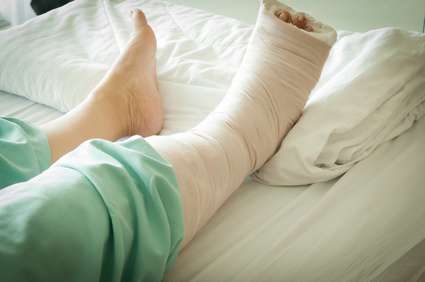Hip Stress Fracture
What is a hip stress fracture
(aka femoral neck stress fracture)?
-
Are you a runner who is experiencing a pain in your groin that’s been building up, the more running you do? Are you concerned you might have a hip stress fracture?
-
Maybe your pain comes and goes, or even moves about? Some days you’re fine, other days it’s horrible when you run.
-
Perhaps you’ve noticed that you can ‘feel’ your leg at night time, or maybe it’s been really painful and has disturbed your sleep?
You may be surprised to hear that your symptoms could be caused by a hip stress fracture.
A hip stress fracture, (which is also called a femoral stress fracture) is an uncommon problem in the general population but is much more common in runners than might be supposed.
Hip stress fractures often go un-diagnosed because of the ‘nebulous’ way in which they present. If they are not treated correctly, the outcome can be very serious, because the blood supply to the head of the femur may be a risk, which can lead to major surgery.
 What exactly is a hip stress fracture?
What exactly is a hip stress fracture?
When we exercise, our bones take on a mechanical load. Our bones are very used to being loaded and every day different kinds of bone cells are breaking down (resorbing) and building up our bony architecture in a way that helps to bear the stress placed on it.
When repetitive loading becomes too much, however, the balance between breakdown and build-up becomes imbalanced, and the bone begins to weaken. This stage is known as a ‘stress response’ within a bone. When eventually a crack begins to appear within the bone, we call it a ‘stress fracture’.
What are the symptoms of a hip stress fracture?
1. The symptoms can be confusing.
The symptoms of a hip stress fracture can be confusing, because the pain can come and go and move around.
Hip stress fractures tend to happen to runners and triathletes; you might be preparing from a marathon or and ironman if you’ve suffered from one. But any sport or repetitive activity with a high-impact (especially if you combine it with regular running) can put you at risk. I’ve seen patients who’ve sustained a stress fracture after being a new attender of LesMills classes and even Zumba.
Lockdown meant many more people turning to running when gyms were closed, and there’s been a spike in hip stress fracture cases.
2. Groin Pain.
You might experience a dull pain or ache in your groin, but equally, you might have pain which seems to move around. One day you might have it in your thigh or buttock, and the next it seems like it’s in your adductor muscles. You may have days when you can run pain-free, and other days where a severe pain switches on, and you have to stop running.
3. You may notice it at night.
Another common symptom is being aware of your hip at night-time. You might not experience actual pain at night, but if you’ve been active that day, you might have an ‘awareness’ of a mild ache, or that you can ‘feel’ your hip. You might also notice it every time your foot makes contact with the ground when you’re running.
The consultation was extremely helpful. Cath was very professional, sympathetic, and understanding. I now feel I can move forward with my hip recovery.
How might I know if I have one?
There’s rarely a sore or tender area when you have a hip stress fracture, and often when your physio or osteopath examines you, there is little to find. But if you experience pain on hopping on your affected leg, it’s a stress fracture until proven otherwise.

 How are hip stress fractures diagnosed?
How are hip stress fractures diagnosed?
You may be surprised to learn that X-rays are poor at picking up femoral stress fractures. If the fracture has actually displaced, it may be detected on an X-ray, but an X-ray cannot rule out a stress fracture, and nor can an ultrasound scan. An MRI scan is the gold-standard test (it’s considered to have almost 100% sensitivity, which is another way of saying that it misses hardly any).
In the past, we may have used a nuclear bone scan to diagnose a stress fracture, but now all that’s needed is an MRI.
If you suspect that you might have a stress fracture, it’s really important that you don’t keep on going with your impact activity. Stop the running and seek expert help straight away. If you’re waiting for an appointment and you have bad pain, it may even be a good idea to get onto some crutches whilst you’re getting sorted out.
What are we looking for on the MRI scan?
Typically, we’ll see a brighter, whiter area within the bone; radiologists refer to this as ‘bone marrow oedema’.
Within the area of bony oedema there will often be a dark line (which is the fracture line). Clinicians talk about compression-type stress fractures (which are commonest in runners and occur in the ‘medial’ or inside side of neck of the femur) and distraction-type stress fractures which occur on the lateral side of the femoral neck.

What is the treatment for a hip stress fracture?
Thankfully, most hip stress fractures will heal well without the need for surgery. Very occasionally, surgery might be advised if the fracture is a distraction-type fracture, or the fracture looks in danger of displacing.
Displaced fractures are an emergency, as the blood supply to the head of the femur can become compromised. This can lead to the death of the head of the femur, which is why it’s so important to get a proper diagnosis and the proper treatment.
If you have (or suspect you may have) a hip stress fracture, it’s best to offload your leg completely onto crutches. That means using two crutches and taking all the weight on your good leg and your crutches. The bone needs time to heal sufficiently, and six weeks, sometimes more, is typically what’s needed to get the mending done.
During this time, you can do upper-body exercise and core training, but you’ll need to keep the weight off your leg.
There will come a time when you’ve been on crutches for a little while, and your pain may be much better, or almost gone, but experience tells us that the hip may still not sufficiently healed, so it’s important that you give it the time that it needs.
You may need a follow-up MRI scan, to see if you’re ready to start re-loading onto your leg.
Once you are able to re-load your leg, you’ll need to go through rehabilitation with a physiotherapist or osteopath. This is necessary to re-strengthen your muscles and to correct any biomechanical issues that will have contributed to the excessive loading of your hip. For example, you may need to build up the endurance and function of your gluteus medius muscles or correct a fault in your running style, such as overstriding.
It’s very important that you work with your therapist to correct any training errors that occurred in the lead up to your stress fracture. Were you ramping up the mileage too quickly, or perhaps you need to be focusing on more strength training?
 Why did I get a hip stress fracture?
Why did I get a hip stress fracture?
There are many factors that come together to bring about a hip stress fracture. Several things can predispose you to get a hip stress fracture, including low bone mineral density (think ‘osteopenia’ and ‘osteoporosis’) and medical conditions such as thyroid and kidney problems.
If you’ve suddenly increased your mileage, have been trying to catch up on a training schedule, or have added in additional impact work (such as a couple of HIIT classes per week), you can be at risk of bone stress.
If your biomechanics aren’t great, or if you’re lacking endurance in certain muscle groups (e.g. if you’ve got weak glutes), then the loading on the hip area specifically may become magnified.
Sleep is also a factor in the development of stress fractures, and a study looking at adolescent athletes found that athletes who slept on average <8 hours per night were 1.7 X more likely to become injured than those who slept for 8 or more hours per night. Make sure you get enough!
Vitamin D (and calcium) have a role to play in bone health, and low vitamin D levels may contribute to stress fractures.
One of the important predisposing factors is what’s known as ‘energy balance’. You may have heard of the term ‘female athlete triad’, which is all about too much training, too little calories, and a wonky or absent menstrual cycle. But men are also at risk of problems with their energy balance, and so now we tend to talk about ‘REDS’, which stands for Relative Energy Deficiency in Sport.
In a nutshell, if you exercise a lot, and you aren’t taking on board sufficient calories, it can bring about a big shift in your physiology. It can affect your metabolic rate, your menstrual cycle, your bone health, your mental wellbeing, and even your immunity.
You don’t need to be underweight or losing weight to be suffering from REDs, and nor does it only happen to people who have an eating disorder. It’s surprisingly easy to ‘under calorie’ , especially if you tend to prefer a ‘clean’ diet and are cranking out the miles.
Dr Spencer-Smith is a very nice, caring, and comprehensive doctor.
How do you know if I might be developing REDS?
One of the signs in women that we’ve mentioned before is absent or erratic periods. REDS can also mess with your sleep (you might wake feeling very tired), it can lower your mood and libido, and you may find yourself generally feeling low in energy.
Another classic sign (which is easier to recognise in retrospect), is that you might experience little bouts of ill health or injury. For example, you may feel like you’re always picking up a cough or cold, you keep getting soft tissue injuries.
Sometimes our behaviour and thought processes can give the game away. Do you ever feel anxious that you’ve missed a training session, or are you restricting yourself to a life of Buddha bowl eating and avoiding carbs?
If this is the case, it’s worth seeking expert advice from a qualified sports dietician or nutritionist. It’s surprisingly easy to fall foul of REDS, and many runners are falling short of the amount of calories that they need to be healthy.
 Do I need any further tests?
Do I need any further tests?
If you’ve sustained a hip stress fracture, I’ll very likely recommend that we carry out some blood tests (to rule out any underlying medical issues, such as thyroid disease, and to check for good levels of Vitamin D etc.)
In addition, it’s important to measure your bone mineral density, with a DEXA scan test. If your bone mineral density levels are low, you may be at increased risk of a stress fracture.
A DEXA scan will determine if you have normal, low (aka osteopenia), or very low (aka osteoporosis) bone mineral density levels (which might lead to further treatment).
The good news is the vast majority of people who sustain a stress fracture of their hip recover fully and get back to the sport they love. If you go through the correct rehab process, it’s very rare to have a second hip stress fracture.




